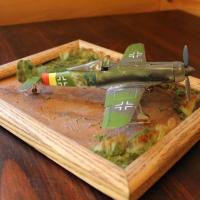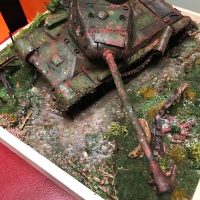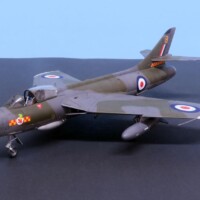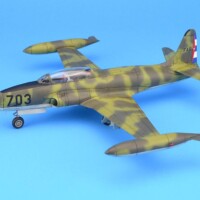Accepted as stand-ins, others get the speaking roles: two GAZ-51(A) lorries with the UPG-250GM and PSG-65/130B superstructures
With this model presentation, I can dispense with any pretence of being an "expert": I am simply not familiar with lorries, especially those used by the military. The question as to why I have then - with no small effort, as will be described later - depicted two GAZ-51 three-axle lorries is therefore not answered by any technical interest in the equipment, but rather by the visual added value that these beefy vehicles offer: as I am planning to build a number of aircraft in the near future whose names begin with "Antonov", "Tupolev" and "Ilyushin", I need a certain visual polish for their model photos. The two vehicles will therefore take on the role of extras on the improvised photo airfields. Their use in my own permanent dioramas, however, is not planned.
This use makes up for certain weaknesses of the two vehicle models. These cannot be overlooked in the photos in this article either: in my opinion, the surfaces look very dented and uneven, the vehicle axles appear distorted from some perspectives and, last but not least, some details are too imprecise, appear washed out - or are missing completely. The reason for this is probably a combination of my inexperience in this area and the really very mixed (well, very poor) quality of the kit parts.
Kit and building experience
The previously unknown manufacturer "Military Wheels" challenges the modeller with consistently unclean and roughly cast moulds and a brittle plastic material, both of which can be quite unpleasant in this small scale. For example, the strange division of the cab and engine cowling into two parts - in the longitudinal direction! -meant a lot of extra work for me. On the one hand, it had to be filled and sanded, which in principle is manageable. On the other hand, the sharp edges, which are absolutely necessary at the upper and lower edges of the windscreen frame, have to be restored at the seams of the two halves - and that's no easy task!
I quickly sorted out the cabin glazing as it was far too thick and full of inclusions and replaced it with material I had cut myself from transparent film. As the glass surfaces consist of flat panes, this was quite straightforward to do. I also found the handrails on the UPG 250 superstructure to be too bulky and moulded far too thick. These were therefore replaced by fitting etched parts from the model ship range.
As I mentioned at the beginning, I was able to approach the project without being too constrained by specialist knowledge and the resulting scruples, so the critical connoisseur may notice one or two inconsistencies, but in the end I am quite satisfied with the result. It's nice to be able to finish something, even if I'm aware that these are not necessarily flawless models
I'm also satisfied with the little that I've learnt about the technical and historical background of these vehicles in the course of my research, because there are some amazing things!
The original: the GAZ-51
In the years of the "Great Patriotic War", the design and large-scale production of a powerful and modern lorry of own production was initiated in the USSR on the basis of the American Studebaker US6 truck known from land-lease deliveries. The basic requirements for the new design were robustness, easy maintenance and reliability
Due to the war, work at the manufacturer Gorkowski Awtomobilny Sawod only started in 1943, but after the construction of several prototypes, a fully developed design was presented in July 1945. This, a robust and reliable lorry that could move a load weight of 2.5 tonnes with a 60 hp engine, was accepted by the Soviet leadership and was put into large-scale production as the new standard lorry from January 1946.
The production figures are overwhelming, the production period impressive: no fewer than 3,481,033 units of the basic design known as the GAZ-51 were to roll off the production line by the end of production in 1975! A further 17,479 GAZ-51s were assembled in Poland - an incredible total.
With such numbers, it is not surprising that the GAZ 51 became the basis for countless variants and modifications. There is hardly a civilian or military application that could not be covered by the GAZ-51. Although more powerful successors, the GAZ-52 and GAZ-53, went into production at the beginning of the 1960s, the GAZ-51 remained ubiquitous in many countries of the former Eastern Bloc until well after the end of production.
The designations of the individual variants usually refer to the different superstructures. The two GAZ-51/ UPG-250GM shown here is a hydraulic tester that was used for mobile maintenance of aircraft hydraulics. The second GAZ-51A/ PSG-65/130B is a pump truck for aircraft fuels.
So both models have their place in the pictures of aeroplanes - I am already looking forward to their use as silent supernumeraries on those stages where the photographed aeroplanes will play the leading role!















Also not a lorrie expert, but I can say that they do look amazing, Roland @rosachsenhofer
Thanks for sharing the background information, very impressive numbers indeed.
Thank you for the words, John!
Once again you demonstrate that persistence is over half the battle. Nice results regardless.
Tom, that´s appreciated!
Great! In Poland after 45 Gaz 51 was produced as "Lublin" truck.
It's a fascinating story with that GAZ-51- thank you for your words
Excellent job on overcoming the build challenges and excellent results, Roland! As always, a great, informative article!
Well done!
hank you for your appreciated words, Spiros!